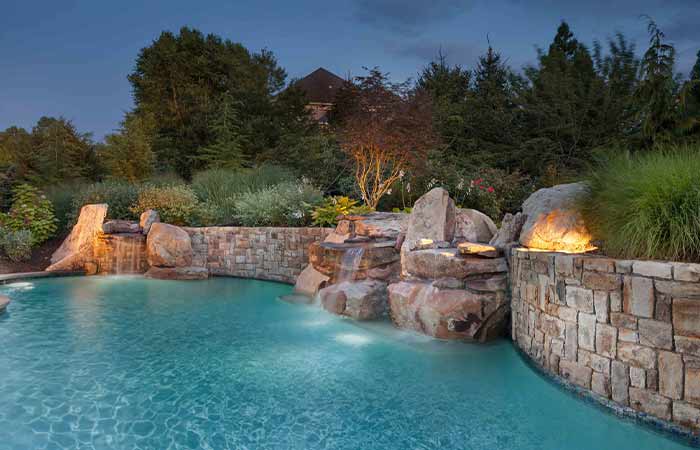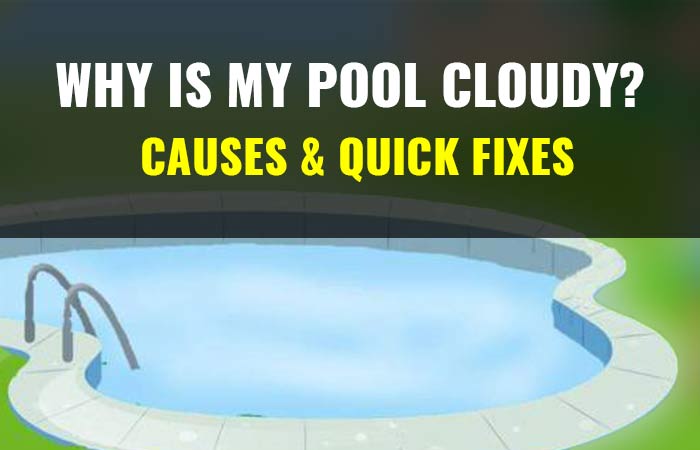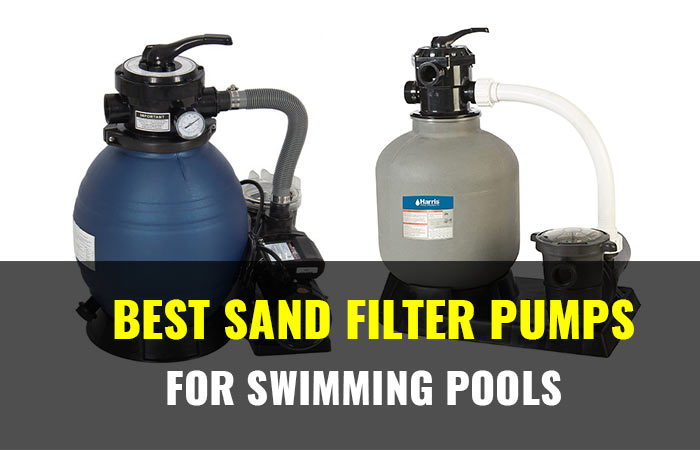Scaling in Pool-Pictures, Removal & Prevention
Pool scaling is a problem that many pool owners are familiar with. These are unsightly mineral deposits on your pool surfaces that mostly result from a high concentration of minerals especially calcium, imbalanced alkalinity and pH levels as well as high temperatures.
To remove scaling, discontinue pool use to test the levels of pH, alkalinity or calcium to ensure they are in the right range. Once the pool chemicals are balanced, all you need is a scale or stain remover to get rid of the deposits.
Depending on what your pool surfaces are made up of, you can also use a pumice stone or a scrub brush with some cleaning solutions
With the appropriate pool water chemical setup and regular maintenance, you can prevent scaling in general.
Following is a detailed discussion on what scale is, how it looks like in pictures, types, causes, how to remove and prevent it.
Pool Scale Pictures
What exactly is pool scale? Scale is a buildup of minerals on your pool surfaces. The most common mineral is calcium but the scale can also be made up of phosphates, magnesium, metals and other particles that are dissolved in your pool water. Following are pictures of how scale in the pool looks like.

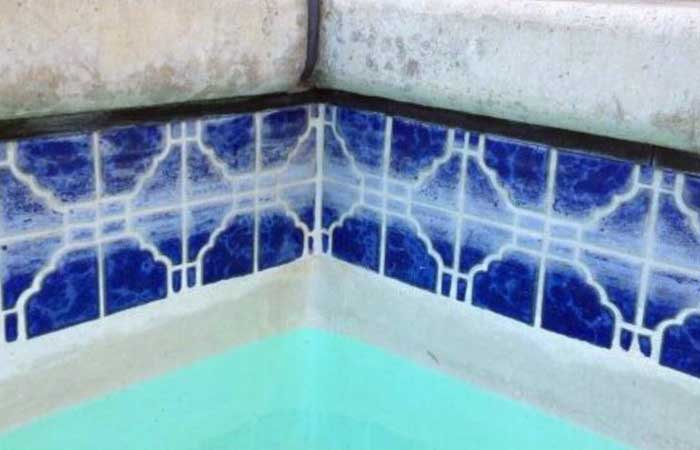

Scaling appears as an unattractive white to white-grey deposit on pool surfaces. It sticks as stains, thin films, dirty spots and sharp crystals.
In severe cases, it can produce a viscous mineral scum on the water level, form coats inside of the water supply pipes, clouding, and even clog up your pool pump. This could result in costly repairs if not corrected on time.
Identifying Pool Scale Types
The main types of pool scaling include the following:
Calcium Carbonate
The first type of pool scale is Calcium Carbonate. Calcium carbonate scaling is the most common type, and it can be treated with either a soft or hard touch depending on your preference. Calcium carbonates are usually white in color but they may also appear yellowish if you have high levels of iron in your water system.
Calcium carbonate scaling forms fast and is quite easy to remove, and Calcium carbonate reacts with muriatic acid as a test.
This type of scaling is usually found in pools that are only used during the summertime or throughout warm weather seasons. Calcium carbonate scaling occurs when calcium from your water supply dissolves into the pool water over time. Because calcium is alkaline, it causes pH levels to rise which leads to scale formation.
A soft touch will clean this up by brushing off any loose debris and then shocking the system using either trichlor or liquid chlorine at 15-30 ppm for 24 hours followed by draining down 50% of your total volume overnight (Tank Rinse).
The next day, you can bring the level back up slowly until you reach your normal range. Calcium Carbonate scaling is soft and can usually be removed by brushing the surface but if you don’t brush it off, then a reaction with chlorine will break down any Calcium that has formed into smaller particles which makes them easier to remove.
Calcium silicate
The other type of pool scaling is calcium silicate. Calcium silicate takes a long time to form and is not affected by acid testing. As such, it’s important that you test your pool water regularly (once or twice per week) for proper treatment. Calcium carbonate can be confirmed using muriatic acid as a test but calcium silicate cannot since it doesn’t react with the acid.
Calcium silicates are extremely difficult to remove because they build up slowly over many years until they become very large deposits of scale on pool surfaces and equipment like heaters and filters. To prevent this type of damage from happening to your swimming pool, it’s highly recommended that you perform routine maintenance to prevent any calcium buildup before it starts.
Calcium phosphate
Another type of pool scale is Calcium phosphate. Calcium phosphates are a crystal that has a cube-like shape and is white in color, often resembles chalk or powdered sugar. Calcium Phosphate scaling occurs when calcium ions present in the water come into contact with dissolved hydrogen phosphate (HPO) to form Calcium Hydrogen Phosphate.
This type of scale can be caused by an imbalance between these two chemicals which leads to saturation levels where Calcium Phosphate starts precipitating out of solution. Calcium hydroxide also contributes heavily to this process because it reacts much more rapidly than hydroxides of other metals such as magnesium and iron.
Calcium carbonate scales will typically grow faster on surfaces exposed to high pH waters while Calcium phosphate scales will grow faster at low pH waters. Calcium hydroxide is an ion that can contribute to pool scale because it reacts rapidly with water, which causes scaling (precipitates) of Calcium phosphates and Calcium Carbonate scales above a specific level known as the “saturation index” or “critical supersaturation ratio”.
Calcium sulfate
There is also calcium sulfate which is a pool scaling chemical that is also a root killer. Calcium sulfate grows fast and will scale/coat your pool’s filter, heater, piping and water lines if you do not backwash it on time.
Calcium sulfate deposits are the least likely to form crystals and will often slowly accumulate over time. Calcium sulfate crystals look like white powdery dust on the walls of your pool or in a skimmer basket if you have one installed.
One way to tell if it is calcium sulfate instead of calcium carbonate scaling is that calcium sulfate looks more granular than crystalline when found inside piping/ lines. If there are only small amounts then backwashing should be enough to clean out any deposits before they become an issue. However, sometimes with high pH levels or other conditions causing this type of scale formation can lead to its rapid growth.
Mineral Scale
This is another form of scale that comes from stone or rock walls. Known as efflorescence, it is a common issue for pools with rock retaining walls. When moisture seeps through the wall, it brings mineral scale which forms ugly brownish-white stalactites on the rock and tile.
If none of the types of scaling above describes what is in your pool, contact a professional who can check your pool and provide the right guide and treatment plan
What causes pool scaling?
Pool scaling is caused by the following aspects:
High calcium and other mineral levels in the water
If there are high calcium levels in the pool, scaling will likely occur. High pool calcium levels are usually caused by mineral build-up or chronic water line leaks.
Scaling is a common issue with traditional concrete swimming pools and can be quite expensive to remove if it gets out of hand. When you have high calcium levels in your pool water, that means there are too many dissolved minerals inside of the water.
As these minerals get deposited on surfaces like tiles and grout lines, they create limescale deposits as well as unsightly stains within the surface area of your pool. This process also leaves behind an uneven residue which damages the appearance and functionality of many components such as jet fittings and valves.
High calcium levels will also cause pool equipment, like heaters and filters, to fail faster due to the increased wear and tear that results from mineral buildup.
High temperature levels
High temperatures increase the rate of chemical reactions especially in the hard water in your pool. This can lead to calcium carbonate being deposited into the plaster of your swimming pool, causing scaling. Temperature levels have to be controlled and kept low if you want to prevent this from happening.
High carbon dioxide levels
Carbon dioxide levels in the water are measured in ppm (parts per million). In order to prevent scaling, it is important that these levels stay below 80ppm. If the levels of carbon dioxide in the water are above 80ppm, the calcium carbonate minerals in the water will react to it, forming a hard scale on your pool surface.
This is usually caused by the overuse of sanitizing chemicals like chlorine or bromine-based shock treatments. When these are used incorrectly (or too much), they cause high levels of chloramines and acids that increase the amount of CO in the water.
The reaction between this excess level of dissolved CO and CaCO scales off deposits onto surfaces in pools leading to unsightly stains as well as increased maintenance costs for upkeep. This can also lead to damage if left untreated such as pitting, etching, scaling and even staining from metals found naturally within treated drinking waters which may add contaminants such as iron into the swimming pool.
High pH levels
Another reason your pool might form scales is high pH levels. When your minerals become high, they dissolve in the water and cause high calcium hardness to form into scales on different surfaces of your pool.
To prevent high pH levels from occurring, you can use a chemical that reduces the amount of free carbon dioxide (CO) contained in the water. You should also have an automatic pool cleaner running throughout the summer months because it helps circulate more fresh clean water through the filter. It also decreases its exposure to chemicals like chlorine which are not good for any equipment when exposed for too long or at high concentrations.
Poor chemical setup of the water
The chemical balance of the water is key to keeping a pool clear and sparkling. Poor chemical balance leads to corrosion of the equipment, infrastructure damage such as popping tiles and eventually scaling which causes cloudy water.
As mentioned earlier, high pH and calcium levels will increase the likelihood of pool scaling. Poor pH balance can be caused by incorrect chemical use, or if the water is affected by outside sources such as rainwater that has not been caught and filtered before entering the pool.
Some chemicals you use for shocking your may do more harm than helping. A good example is calcium hypochlorite which adds calcium to the pool. Chlorine-based shock chemicals also disrupt stain & scale chemicals(sequestering agents), if added at the same time.
Too much clarifiers in the pool can act as a dispersant instead of a coagulant. Again, too much clarifiers used with sequestering agents at same time can lead to pool staining
How to Remove Scaling in Pool
To get rid of pool scaling, use the following steps:
1. Test your Pool water
The first step is to test your pool water. First, stop using the swimming pool. Stop adding chlorine to it and stop going for a swim in it until you are able to clean off or remove all of its scale build-up from the walls, floor, steps, floors and even equipment.
Next, you should test the water for alkalinity, pH and calcium levels. Test kits can be purchased at a local pet shop or hardware store. If you choose to use your pool’s chemical dispenser, make sure that it is in good working order and that all chemicals are properly balanced before using it to treat the water.
Lowering the calcium hardness in the water
Calcium hardness is a measure of how much calcium is in your pool water.
The simplest and fastest way to lower high calcium hardness is to partially or completely drain your hard pool water and replace it with fresh water.
If replacing the water does sound not a good option, you can use pool flocculant which makes the calcium build-up to clump together after which you can use a vacuum to get rid of the clumps.
As a precautionary measure, do not use the floc with your filter and pump on. Always remember to turn them off to avoid damages. It a floc is also not recommended if your pool uses a cartridge filter If you find that your calcium levels are still high, adding muriatic acid can help. This chemical adjusts the alkalinity of the pool which, in turn, balances out your pool water.
Lowering the alkalinity
You then need to lower the alkalinity of your water. Lowering it will be a gradual process, and you will not need to do this all at once but over the course of several days.
The best way to test how much you should lower it is by using pool store test strips. Your pool should be in the 80 – 120 ppm alkaline range.
Make sure the total alkalinity(TA) is neither too high nor too low. Low total alkalinity results in rapid pH fluctuations and aggressive pool water, for both humans and pool parts.
High total alkalinity on the other hand makes the pH difficult to adjust and result in lime precipitation, cloudy and murky water.
Adjusting the pH
The next aspect to adjust is the pH level of your pool. Lowering the pH will allow you to adjust the alkalinity as well and prevent scaling from occurring in your pool. The ideal pH range for a swimming pool should be between 72. and 8.0.
Ensure that the PH is not too low. Low PH turns the pool water more acidic. Acidic water is corrosive and it not only negatively affects the swimmers but also the pool surfaces. For swimmers, it results in itchy dry skin and irritated eyes. Acidic, low pH water corrodes metal surfaces and pool accessories as well as pitting, etching, cracking and delaminating of pool walls and surfaces
2. Use the appropriater Pool Scale Remover
Once testing and adjusting the calcium, pH and alkalinity the final step is to clean out the scale. Following are some of the tools and cleaning solutions you need.
Muriatic Acid
Muriatic acid is one of the most effective scale removers. Our recommendation is Acid Magic
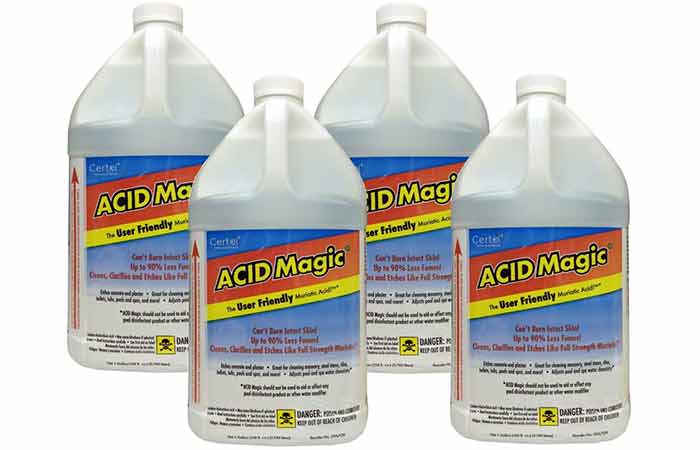
It is full strength 1-to-1 replacement for muriatic acid. This product has all the cleaning, etching, and PH reduction properties of powerful acids but with 90 percent less fumes – it will not cause burns to intact skin.
Acid Magic is one of the best products for dissolving calcium deposits on filter cartridges, and for cleaning tile and concrete
Pool Metal Out
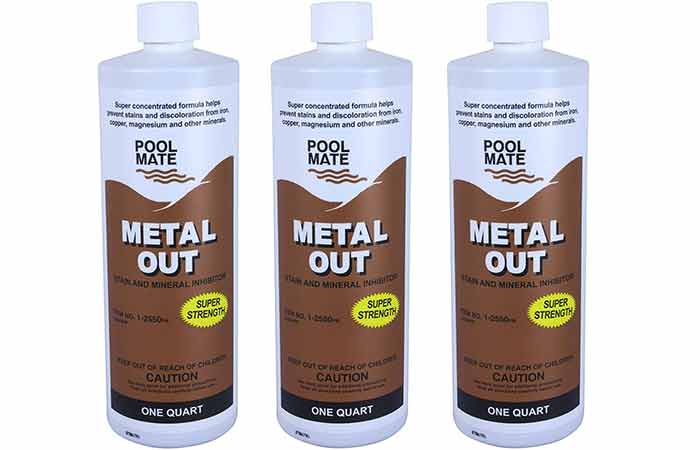
Buy it from Amazon
Pool Mate’s Metal Out pool product helps prevent discoloration of pool water due to iron, calcium, manganese, copper and other metals and minerals which may be present in the water supply
It is an excellent general-purpose sequestrant that helps protect plumbing and pool walls from rust, stain and scale
Descaler and Stain Remover
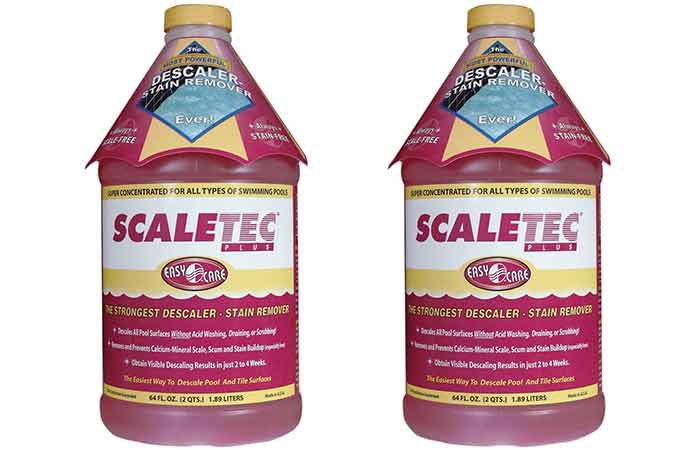
One of the most popular descaler and stain remover is the EasyCare Scaletec Plus Descaler. This product removes calcium buildup and other stains without scrubbing, acids, or pool draining
Note: If you are using a chlorine-based sanitizer, add stain & scale chemicals a day before or several days after. Otherwise, use a non-chlorine oxidizer, or di-chlor pool shock.
Pool Scrub Brush

This is a heavy-duty 18″ swimming pool scrub brush for cleaning pool walls, tiles & floors. It is made up of Aluminum and stainless-steel wire bristle.
You can use this scrub brush with vinegar, muriatic acid or pool Clorox bleach
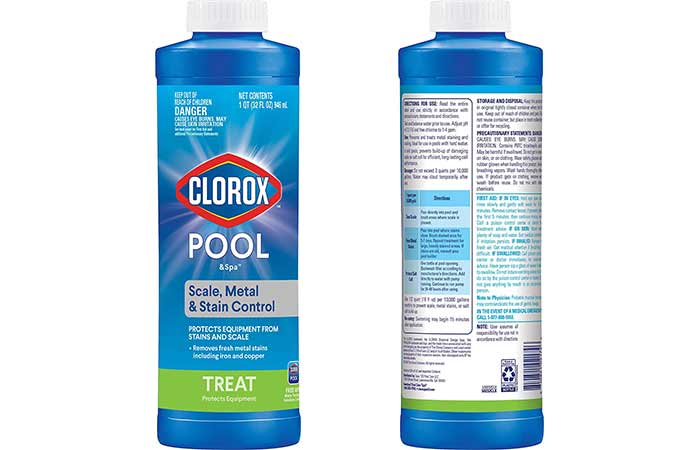
Pool Pumice Stone
If you have tile or concrete, a pumice stone is one of the best tools you can to remove scaling. To avoid scratches, ensure that you keep both the pumice stone and the surface wet.
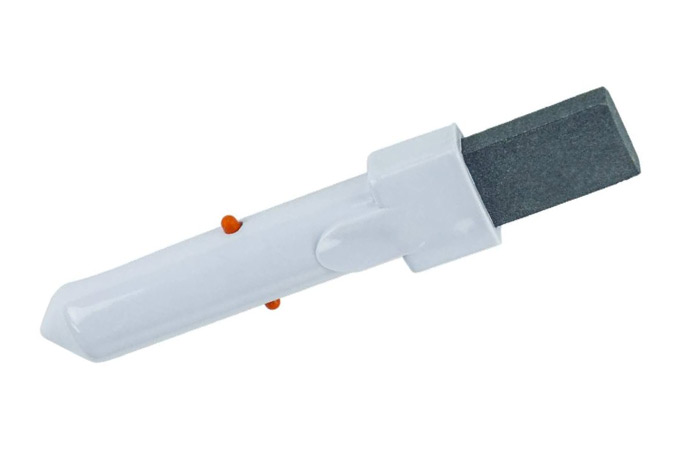
Pool Pumice Stone with EZ-Clip Handle is a good option to try out. It erases rust stain spots in concrete plaster pool spa and calcium deposits on pool tiles
With the above steps and cleaners, your pool should look much better than before. It’s likely that you’ll still see some minor discoloration or blemishes here and there but these can be easily remedied by following steps one through four above until they’re gone.
If anything remains after cleaning the entire wall area thoroughly, it might indicate an underlying problem in parts of the system which need further attention. For example: if a black scale appears on white plaster while grey/white scales are present elsewhere then iron staining has likely occurred and it’s time to contact a pool refurbishment professional.
Removing Scaling from Fiberglass Pool
To remove minor scaling and other metal stains, rub a vitamin C tablet directly on the affected areas to release the stains from the pool surface.
Add an appropriate amount of sequestering agent to bring together the released metal stains.
Form major metal staining, use ascorbic acid and a sequestering agent.
You can also use a stain eraser to remove calcium carbonate scaling from a fiberglass pool.
For tougher stains and scaling that you cannot handle seek help from your local pool care professionals.
Preventing Scale in Pool
To prevent the ugly scaling in your swimming pool, use the following methods:
Keep a low pH
You should keep the pH in your pool between seven and eight, which will minimize scaling. Keep a good alkalinity level as well (80-120 ppm). If you notice any calcium build-up on surfaces or at the bottom of your pool, it means that one of these levels is too high.
Remove calcium by reverse osmosis
If your pool is prone to scaling, then you should definitely consider reverse osmosis filtration. This is a specific type of filtration that denitrates the water by removing calcium and other minerals found in your pool.
These minerals are very important to have present because they help maintain acidity levels, but if there’s too much then it can be harmful to the surface area of your pool.
Reduce evaporation with a pool cover
You can reduce the amount of water lost through evaporation by covering your pool with a tarp or another type of cover. A simple, inexpensive sheet will dramatically reduce the loss in volume and chemical levels that occur over time.
Install a pre-filter
You can catch particulate matter with a pre-filter before it gets into your pool. If you install a pre-filter for your pump, the filter will catch any debris before it can get to other filtration system components and cause scale build-up.
Pre-filters are available in mesh form which allows water through but prevent leaf litter from getting into the equipment area of the pump or cartridge type that may need replacing less often.
Perform Regular LSI Test
An LSI (Langelier Saturation Index) test determines a pool’s preponderance for scaling or etching. The ideal results should be somewhere between -0.3 to +0.3. Test results below -0.3 indicate a prevalence toward corrosion – and above +0.3 and your water is ‘scale-forming’.
Owing to the fact that stain-removing and descaling chemicals naturally degrade in sunlight, be sure to add some amounts of these chemicals every few weeks to maintain a residual level and keep the calcium and metals locked in solution
Ensure your pool is always clean to keep organic waste levels to a minimum. Bio-matter in the pool, including algae, coagulates to form dirty stains, especially during scaling events.
Do add some clarifier to seek out calcium particles and clump them together. This makes it easier for filtering and eventually removing
Monitor the pH of your pool water, the ideal range should be between 72. and 8.0. Some pool care pros also recommend a range of 7.4 to 7.6.
Regularly brush your pool to remove any newly-formed scale, and vacuum or run your pool cleaner some days every week to remove calcium dust and dirt.
With these tips, you can be ready to combat calcium scaling in your pool much easier. Keep in mind that pool scaling is majorly caused by a chemical imbalance and constant monitoring the chemical state of your pool will do the trick.

